

The sunlight or white light is composed of seven colors as shown:
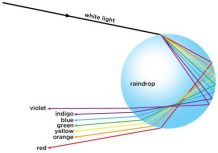
Rainbows can be seen not just on a rainy day, but also in mist, fog, and dew, whenever there are water drops in the air and light shining from behind.
A rainbow is a natural optical phenomenon and a spectacular display of dispersion of light and observed in the form of a multi-colored arc in the sky when there are suspended water droplets in the air after the rain and the sunlight shining from behind at low altitude angle.

The spherical droplet of water acts like a small glass prism disperses the light into seven colors. When sunlight enters a spherical droplet of water, it is refracted or dispersed into different colors at different angles and each color is reflected off the back of the drop and again refracted when they leave the drop.
The light changes its speed and direction as it moves from one medium to another medium. For example, when the sunlight passes through glass prisms from rare medium to denser medium it changes its speed, direction and disperse into seven colors i.e., (V I B G Y O R)
Reflection is the bouncing back of light. Refraction is the bending of light as it passes from one medium to another.
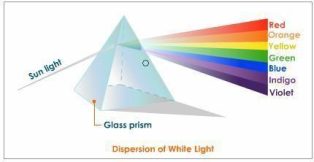
Each color of the spectrum gets refracted by a different amount when it passes from air to water or from water to air, the same as happens when light passes through a prism. Consequently, the rainbow circle is not 42 degrees for all colors. The circle is 40 degrees for blue rays and 42 degrees for red rays, so the primary rainbow is blue on the inside and red on the outside, with the intermediate colors of the spectrum spread out in between.
Primary and secondary rainbow
In a primary rainbow the arc shows red on the outer part and violet on the inner side. In a secondary rainbow the arc is much fainter and can be seen outside of the primary arc. This is caused by the light reflecting twice inside the water droplets. As a result of this double reflection the colors of the second arc are inverted with violet on the outer edge and red on the inner edge.
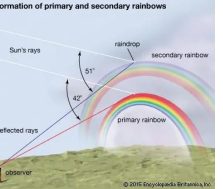
In the case of a secondary rainbow the rays make an angle of 51 degrees. The secondary arc therefore appears outside of the primary bow.The sequence of colors is reversed in the secondary rainbow. Every color emerges at different angles e.g., red emerges at 51 degrees and blue at 54 degrees. The secondary bow is twice as broad and dim than the primary rainbow.

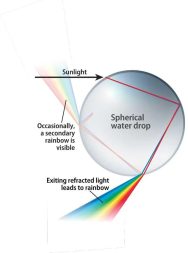
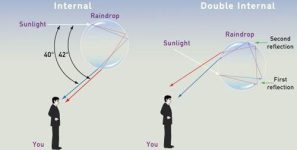

Zia Ahmed Khan
email khanziaahmed50@gmail.com